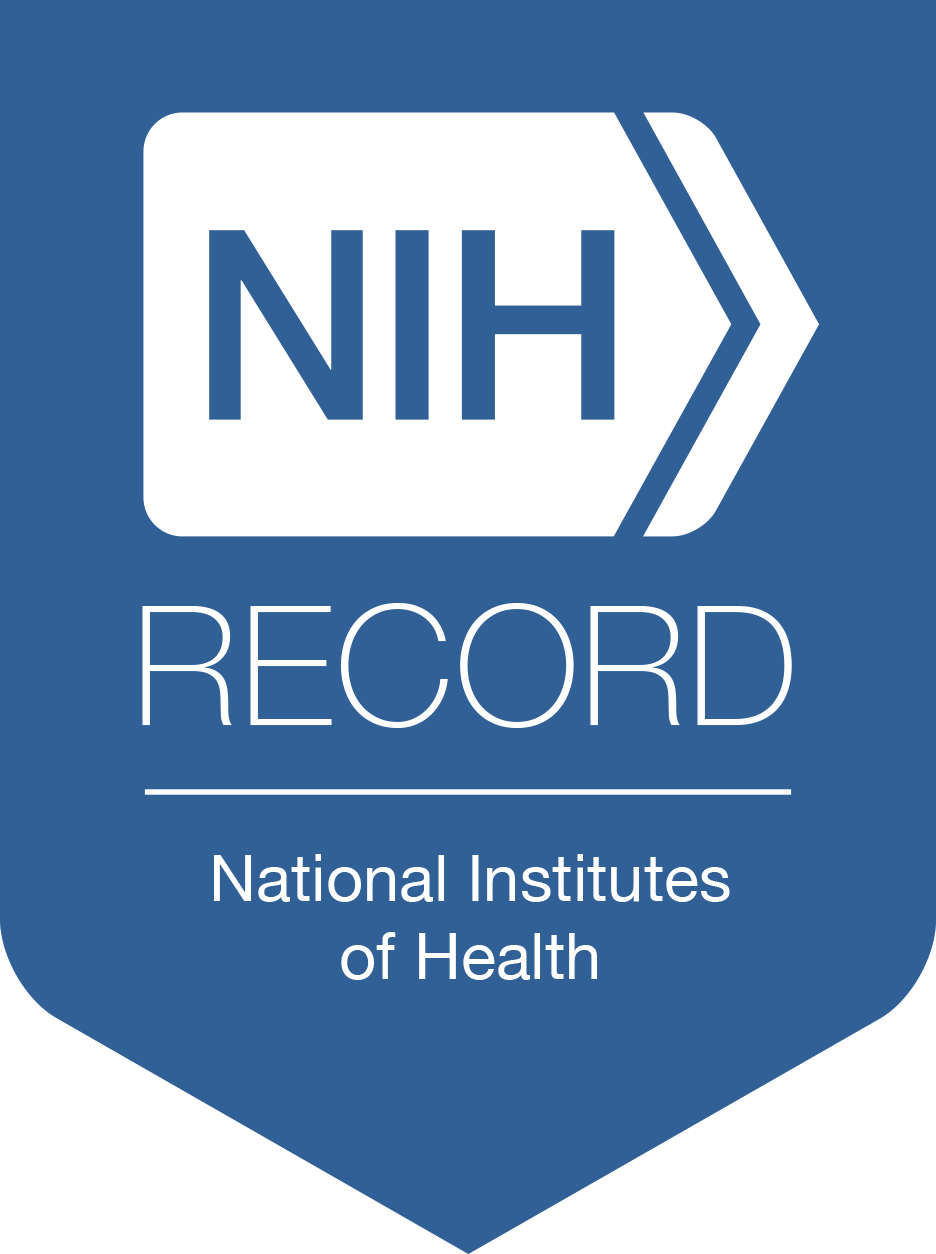HHS’s Plescia Tours NIH Labs, Meets with NIH Leaders
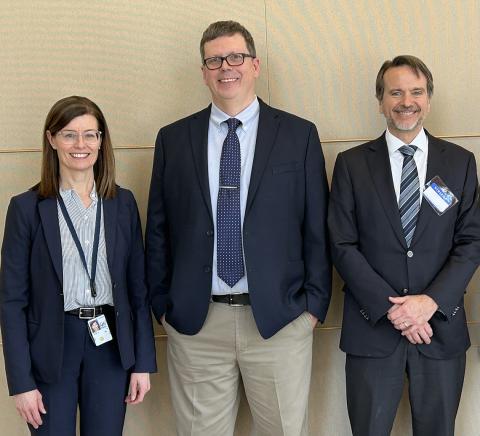
Photo: Dana Talesnik
In March, Deputy Assistant Secretary of Health Dr. Marcus Plescia spent the day at NIH getting an up-close view of some of the groundbreaking research taking place in NIH labs.
Throughout the day, he visited pediatric cancer, metabolic and vaccine research labs and met with NIH senior leaders to discuss NIH’s role in addressing chronic diseases, obesity and other Administration health priorities.
Plescia—a family medicine doctor who has served in multiple public health roles—is also director of the Office of Science and Medicine in the Office of the Assistant Secretary of Health (OASH) at the Department of Health and Human Services (HHS).
He arrived eager to learn more about cutting-edge studies and see some of the innovative work firsthand.
Pediatric Oncology
Several investigators from NIH’s National Cancer Institute (NCI) discussed advances in diagnostics and therapies for childhood cancer. One long-term challenge has been how to address tumor complexity. Dr. Jack Shern, a physician-scientist in NCI’s Pediatric Oncology Branch (POB), is addressing this challenge head-on using single-cell sequencing.

Photo: Maria Maslennikov
“Now we can do things like look at every cell type in the tumor,” he said, noting the technique can distinguish among tumor, immune and vascular cells and study them in depth. “That’s one way we’re solving the heterogeneity.”
Dr. Andrea Gross, a POB assistant research physician, described a benign tumor type, plexiform neurofibroma, that causes significant complications as it grows including pain, disfigurement and breathing difficulties. Another complication, Shern noted, is that part of the plexiform can become cancerous, making it difficult to target and treat.
Gross is part of Dr. Brigitte Widemann’s lab, which studies neurofibromatosis type 1 (NF1), a genetic disease that causes tumors, neurocognitive difficulties and bone abnormalities. One of her patients, Philip Moss, was visiting the Clinical Center for a checkup, and stopped by the lab to greet Plescia.
Moss is 1 of 50 patients from a NF1 trial that began a decade ago. At age 8, Moss had a growing tumor on his neck. He recounted being scared coming to NIH as a child. “Now that I’m older, I appreciate the medical care and the culture here,” Moss said. “I’m eternally grateful to [my NIH doctors]. Without them, I wouldn’t be here today.”
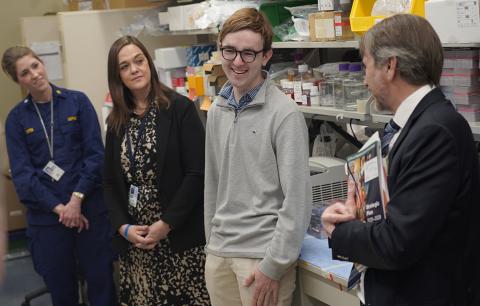
Photo: Maria Maslennikov
Results from that study led to the first FDA-approved medication for NF1, a treatment that is now available in more than 50 countries. “Now patients around the world have treatment options,” Gross said. “We’re excited about this but we’re not stopping there.”
Gross noted the need to find treatments for the 10-15% of NF1 patients who develop aggressive cancers with poor survival for whom there are currently no good treatment options. The team continues to develop and test treatments and ways to detect tumors earlier, while they’re small and localized.
One such diagnostic tool involves measuring cell-free DNA—which is shed from regular cells and cancer cells—from a simple blood draw. There’s evidence that this test may detect malignancies earlier than imaging scans.
“It might not only be useful for diagnostics,” said Dr. Taylor Sundby, an assistant research physician in Shern’s lab, “but also to help figure out whether we need to escalate or de-escalate care.”
Genomics research, started at NIH decades ago, is further transforming the field and enabling what’s becoming possible.
Metabolic Unit
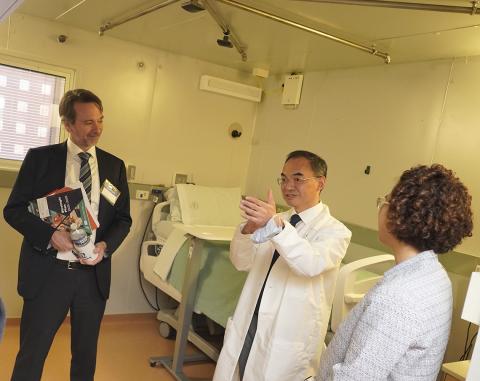
Photo: Maria Maslennikov
In the Metabolic Clinical Research Unit, researchers study diabetes, obesity, liver disease, cancer, neuromuscular, cardiovascular and other chronic diseases.
“It’s a unique facility offering specialized studies in metabolism, which provides value and insights into many conditions that are affecting so many people,” Dr. Griffin Rodgers, director of NIH’s NIDDK, told Plescia.
Senior Investigator and co-director of the metabolic unit Dr. Kong Chen took Plescia inside one of NIH’s metabolic chambers—an open-circuit and air-tight space that allows for non-invasive studies related to whole-body energy expenditure and fuel utilization while monitoring changes in heart rate, movements, body temperature and other physiological measurements. The environmentally controlled room, which is supplied by medical air and has a bed and toilet, houses the patient during their hours- or days-long study.
“One of the real strengths of these metabolic chambers is the ability to accurately and precisely measure changes in physiology or pathophysiology,” Chen said. “For example, food intake changes of even a few percent matter chronically, as do small metabolic changes if such changes are not compensated by each other.”
The studies range from understanding metabolic adaptations to common weight loss and weight regain to finding causes and treatments for rare conditions in which, for example, people cannot digest proteins or fats.
Obesity is a staggering problem in this country and one that HHS has a keen interest in tackling. Rodgers noted NIH clinical researchers aim to find precise strategies to help address it.
Vaccine Research
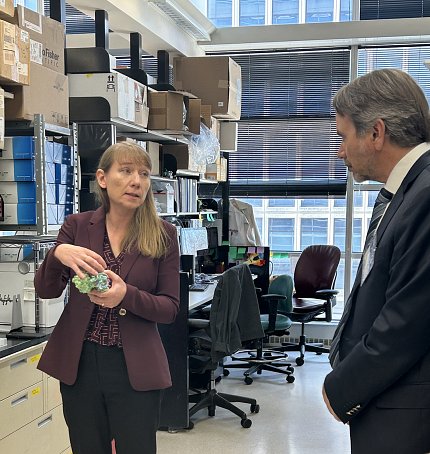
Photo: Dana Talesnik
Plescia headed from the Clinical Center to the Dale and Betty Bumpers Vaccine Research Center (VRC), where VRC Director Dr. Ted Pierson and VRC investigators described the critical research done there.
At the VRC, researchers perform basic and translational research on infectious causes of acute and chronic illness to promote health through disease prevention. Central to their unique approach is the translation of fundamental discoveries into experimental medicine by developing novel biologicals to test in first-in-human clinical trials. VRC researchers study the biology of pathogens—how they work, their physical structure, why they cause disease and how they evolve and interact with the immune system.
Achieving these goals often involves developing state-of-the-art analytic tools and technologies. One example is an exceptionally rapid method to identify and clone antigen-specific antibodies from individual B cells. The antibodies guide the discovery of vaccines and can be candidates for new therapeutics.
“We’re discovering around a thousand new monoclonal antibodies a week,” noted Pierson.
The VRC’s efforts contribute to addressing unmet public health needs, the government’s biosecurity objectives and NIH responses to public health emergencies, Pierson told Plescia. Its investigators have made significant contributions to vaccine science for HIV, influenza, RSV, Ebola and COVID, to name a few, leading to vaccines which have been deployed around the world.
During his tour, Plescia visited two VRC labs. Dr. Tongqing Zhou, chief of the structural virology and vaccinology section, described how he and colleagues pioneered strategies to stabilize viral proteins to advance vaccine design.

Photo: Dana Talesnik
In describing how viruses such as HIV-1 engage with human receptors, Zhou said, “I call it the initial handshake that triggers a big bear hug. Then they begin the infection process.” Because some viral proteins change shape, he noted, they become moving targets, making them more difficult for the immune system to attack.
Using tools like an electron microscope that can magnify proteins over 100,000 times , along with artificial intelligence (AI), Zhou’s lab is deciphering the mechanisms of viral immune evasion and antibodies function, applying that knowledge to design new therapeutics. He called AI a game-changer in accelerating scientific discoveries.
Plescia also learned about novel influenza studies. Dr. Sarah Andrews, chief of the B cell immunobiology section, is studying how preexisting immunity—from prior flu infections dating back to childhood—is helping or interfering with the body’s response to flu infection or vaccination decades later. She described a clinical trial where they studied the response to a particular flu strain in participants who, because of the timeframe when they were born, did or did not have prior exposure to that flu strain. The trial results highlighted the lifelong impact of flu exposure early in life and are informing further studies.
Andrews also discussed pandemic preparedness efforts. In one study, they pulled samples from the freezer from people who were vaccinated with a bird flu vaccine in 2010 to find antibodies that could bind to the bird flu strain currently infecting birds and cows. Doing high-throughput screening, they found five antibodies that were broad and potently neutralizing against many bird flu strains, which suggests they could be effective at protecting against current and future bird flu strains. “We’re pursuing these for therapeutic purposes in the event of a pandemic,” she said.
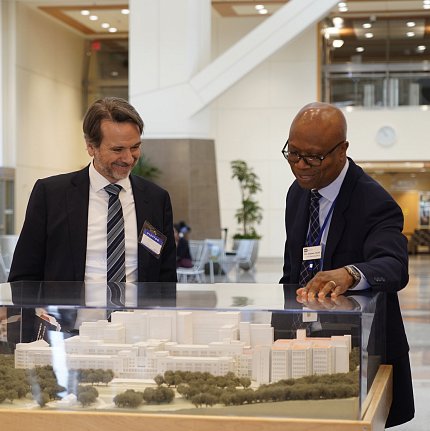
Photo: Maria Maslennikov
It’s a collaborative effort, noted Andrews. She’s an immunologist and relies on the expertise of a flu research team that includes virologists, structural biologists, and viral sequencing and technology experts. “What has kept me at the VRC is the ability to collaborate with all of these different people with different areas of specialty,” she said. “I think that’s the power of our work at the VRC.”
Pierson also underscored the importance of multidisciplinary teams in discovery science. “Most of what we do is basic science,” he told Plescia, “and that’s done in this building [Bldg. 40]. All of that work leans into solving problems that address unmet public health needs. Some of those discoveries create opportunities for experimental medicine.”
The integration of all the specialized expertise to quickly turn ideas into translational concepts within a single organization is what makes the VRC unique.
